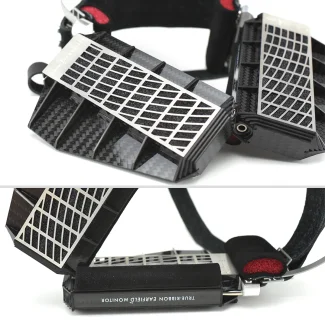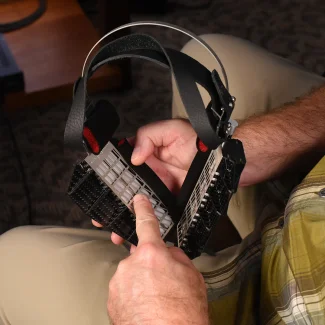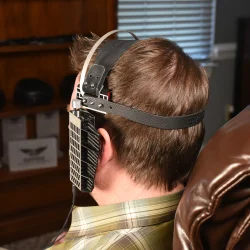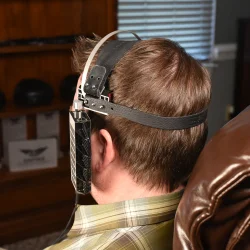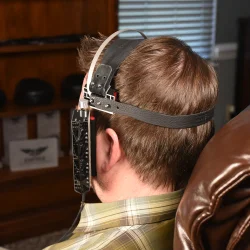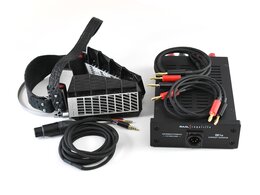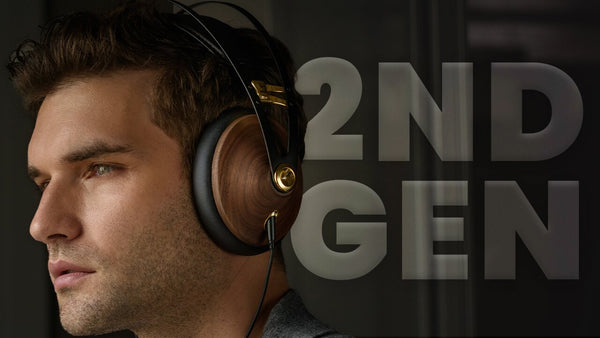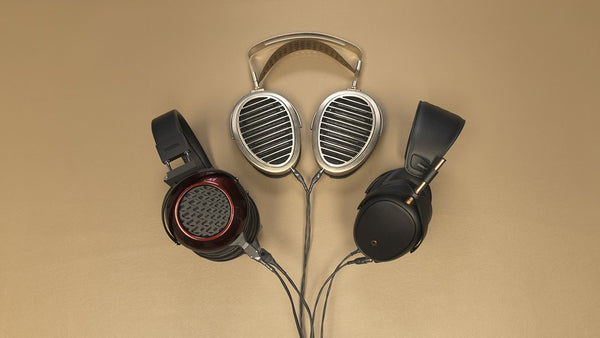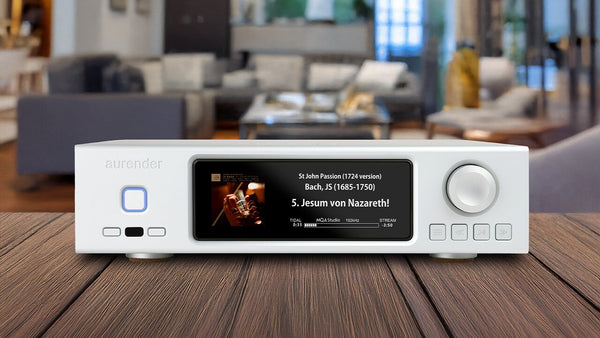RAAL SR1a Headphone Review
Read Time: Approx. 22 min.

True Ribbon Earfield™ Monitor Puts the Sweet Spot "Out There"
The term "ear speakers" may conjure up an image similar to people carrying impossibly large boomboxes on their shoulders in the '80s. You wouldn't want -- and couldn't if you tried -- to wear speakers on your ears.
With the SR1a by RAAL-requisite, though, you are getting speaker-like sound from something you wear on your head that weighs less than a pound.
Unlike conventional headphones, there are no ear cups on the SR1a; instead, this is an open-baffle design with a rectangular stainless-steel face that is reminiscent of a cheese grater. But you'd never guess just how amazing they are until you put them on. Billed as the world's first Earfield™ Monitor, these space-age-looking marvels are putting the sweet spot "out there" for a truly magnificent and unique listening experience.
The SR1a uses driver technology derived from RAAL's aluminum ribbon tweeters, something wholly unique among headphones. These highly specialized ribbon drivers have a frequency range of 30Hz to 30kHz in order to eliminate the need for sealed chambered bass and allow for open air baffles (both front and back) for a true full-frequency soundfield.
The SR1a is a co-creation of RAAL Advanced Loudspeakers founder Aleksandar Radisavljević and Requisite Audio founder Danny McKinney. RAAL, established in 1995 in Serbia, manufactures ribbon tweeters. Requisite, based in California, has been designing and building pro audio gear since 1995. Danny and Aleks have worked on various projects together, with the goal of designing and make a ribbon ear speaker that would remove room acoustics distractions from the listener. The teamed up to form RAAL-requisite, with the SR1a being manufactured in Serbia.
Not Your Typical Headphone
The idea of speaker-like sound in a headphone will elicit various reactions in the audiophile world, ranging from "Not possible!!!" to "Huh?!" to "You have to try it to believe it."
Well, I tried it. But before I share my thoughts, let's look at what makes the SR1a different from a traditional headphone. In fact, from here on out I will refer to the SR1a as an ear speaker instead of a headphone.
The most obvious thing is that there are no ear cups. The open baffle design means that the drivers hover near the ears, but do not enclose them. The drivers hang from a flexible and springy steel band. Having the ability to adjust the angle of the drivers changes the dispersion of the sound. This provides a hard-to-get "sweet spot" in terms of imaging. The listener can easily adjust the drivers forward and back to achieve the presentation of a speaker. For more projection and a wider soundstage, you angle them forward; if you want more bass and tighter imaging, you bring them back. On the back part of each earpiece is a "wing" that increases the surface area of the baffle, which facilitates deeper bass.
Another significant thing: The low impedance of the SR1a makes matching it to a suitable amp difficult. You cannot use a traditional headphone amplifier; the SR1a needs to be driven by a specially designed high-power headphone amp or a moderately powered speaker amp connected to the interface box that comes with the SR1a.
Ribbon drivers have an extremely low resistance, and most typical speaker or headphone amplifiers can't handle the loading. A stepdown transformer and resistive network is required to provide a manageable load if you want to use a typical speaker amp to drive these. Without the right circuit, the frequency response will be compromised and there will be a substantial loss in sound quality. Just having a powerful headphone amp that can deliver higher wattages is not enough to handle the load characteristics of the SR1a. You need a specially designed headphone amp such as the RAAL HSA-1b or the Schitt Audio Jotunheim R.
Note: According to RAAL-requisite, you can use an amplifier up to 500 watts, but care must be taken not to overdrive the ribbon. If this happens, you'll notice a slapping sound, which means the ribbon is reaching its excursion limits. For this to happen, you'd have to be listening to bass-heavy music with the volume cranked.
Also of note, the SR1a is fully modular, meaning you can easily replace the parts. This includes the cable, the cushions, the headband, and the ribbon drivers, which are encased in cartridges that slide easily in and out of the SR1a's shell. Replacement cartridges cost $150 each. The SR1a also includes a limited five-year warranty.
Design
I'll be honest: I didn't find immediate comfort with the SR1a. Now, this was partly because I kept wanting to position the drivers like ear cups (even though I knew better), and partly because I didn't take the time to adjust the headband properly to fit my small head. Once I did so, I felt like I had a secure fit. Note: There is also a leather band that wraps around the back of the head, and the tightest notch on that was too loose. I suppose I could have punched another hole if I had the right tool. While the looseness of the band didn't compromise the SR1a's ability to stay on my head, it would have been nice to have it snug against the back of my head. I'm told that there are plans to add more hold to the strap.
Once I got used to the SR1a, I appreciated the deviation from any pressure against my ears or any real feeling of weight on my head. I expected them to feel heavy, but they didn't. My ears and head felt liberated.
The SR1a features a set of plush memory foam bars along the front of each carbon fiber baffle; this keeps the SR1a on the head and away from the ears. The SR1a is comfortable once positioned properly, but keep in mind that you can't lie down with them on. Also, take care to remove any earring(s) before you put them on, lest they get pulled toward the stainless steel face. Oh, and the grates on the plates are rather rough and sharp, so take care not to slide your fingers over them.
The SR1a has an industrial look and feel that is striking and unique. It doesn't have the polish of many high-quality headphones, but it conveys a sense of being sturdy and durable. I wasn't inclined to be rough with them, but I had the feeling that I could afford to be -- within reason.
How to Position the SR1a
RAAL-requisite offers guidance on how to position the SR1a, both horizontally and vertically. For initial horizontal positioning, they suggest starting with the inner grill about 1/4-inch from the edge of your outer ear. This position is good for most recordings. For acoustic and orchestral music, you are encouraged to experiment with wider horizontal positioning.
For vertical positioning, the ear canal should be at the vertical center of the left and right ribbon. Adjustments can be made via the leather headband. As mentioned previously, you angle them forward for more projection; you bring them back for more bass and tighter imaging.
Moon Audio's Drew Baird experimented with positioning and offered his thoughts.
Let me first say there is no right to wrong to how you position the SR1a on your head as long as you follow a couple of guidelines. First, there are five fins on the carbon fiber plate. The center one should be level with your ear canal. Adjust the top head strap to align as close to possible with your canal. There are three top headband adjustments. Mine worked out to be in the middle and almost perfectly gave the right elevation..
The second important positioning consideration is to line up the driver so that the front-to-back part also centers on your ear canal (see the image where I point to the central part of the driver). The rear headband comes into play for this positioning. Note the headband does not have to be tight on the back of the head to provide this positioning, but should be used as a guide. It was tight on my above-average-size head, but was a bit loose for Sara, the review writer. RAAL is talking about offering straps with more holes to make further adjustments.
Once the headphone is aligned in the X and Y planes, you can adjust the angle of the drivers for best results based on your desired sweet spot. Again, there is no right or wrong angle. I tried three:
Experiment with driver positioning to find the best sound for your music:
Angle the drivers toward your head for more bass and tighter imaging or Angle the drivers forward for more projection.
You could go even farther with the angle if you want. It wouldn't be enough bass for me at this point, but it might be cool with spatial-sounding music. The balanced location was definitely my favorite. Definitely experiment and find what works for you.
Sound
Review Setup
I chose the Pass Labs INT-60 integrated amplifier (100w into 8 Ohms) for my review. Unlike most solid state amps that are neutral- to forward-sounding, the INT-60 leans slightly warm, making it a good match for the analytical-sounding SR1a.
I connected the SR1a to the interface box with a Black Dragon Premium headphone cable (more on my cable choice in the Cable Recommendation Section below). You plug the 4-pin female/XLR cable connector into a 4-pin male/XLR connection on the front of the interface box, which adjusts the SR1a's impedance to a 5.6 Ohm load that enables it to work seamlessly with the amplifier. Note: The XLR "gender reversal" is a fail safe so you don't connect the SR1a to a conventional balanced headphone amp.
The interface box was connected to the Pass Labs amp with a Black Dragon speaker cable, and the amp was connected to a Bricasti M-21 DAC with a Black Dragon Interconnect. Black Dragon power cords were used with the amp and DAC. I also used a Roon Nucleus Music Server for streaming.
I later swapped the Pass Labs amp for a pair of Dragon Inspire QMB-25 Mono Block Amplifiers to get a sense of how the SR1a would sound with tube amps.
During a subsequent testing session, I listened to the SR1a with the RAAL HSA-1b headphone and speaker amp.
The SR1a is like nothing I've ever heard in a headphone -- a simple statement about a profoundly novel experience.
The sound wasn't concentrated or congested in my head. It was hard to remember that I was wearing something on my head, because I wasn't thinking much about my head at all! My music was in front of me. And beside me. And above me. Even behind me, sometimes tumbling through my cranium on a diagonal.
So what did it sound like? The SR1a has a neutral, uncolored, and analytical signature. The sound quality is pure, smooth, and as clear as I've ever known. I was surprised by the bass response, which I wasn't expecting from a driver known for treble. It's not bass-heavy, but it was more than I expected, with lots of texture and definition. Now, in order to get the amount of bass I desired, I had to angle the drivers more toward my head, which narrows the soundstage. It takes a bit of trial and error to find that balance, and it will differ for everyone.
The amount of detail retrieval was beyond what I could have imagined. It was comparable to (maybe a notch above) the Focal Utopia, but with the added element of the "out in front of you" soundstage.
On the Leo Kottke and Mike Gordon version of "Sweet Emotion" -- a funky, swampy interpretation of the Aerosmith classic -- I couldn't get enough of the crack of the drums and the shuffling of the objects of the shakers. This immediately enticed me to play several other tracks that feature a variety of percussion. The crisp "thwacks" were just so taut and satisfying to me, becoming almost hypnotic on a track like "The Obvious Child."
I had a neat experience with "Fakin' It," when in the middle of the song you hear a door with some bells open, and a woman offers a greeting while walking across the floor. I'll be darned if she didn't come in from the right, move to the left, and then walk off behind me. Another thing I noticed with this track was that the bassline was really discernible. It's not powerful -- nor is it meant to be -- but it was distinct and defined.
Treble extension is nothing short of amazing with the SR1a. The highest of the highs sounded sweet and airy but never screechy or harsh or fatiguing. Joan Baez's voice, which can be "too much" on mediocre equipment, sounded as clean and pleasingly powerful as I've ever heard.
Something to note about the SR1a is that a great recording will sound amazing, but a subpar recording will still sound subpar. I listened to a recording of "Helpless Hoping" that has sounded muddy to me on several headphones, and that quality didn't change. (Layering of vocal harmonies, though, was an entirely different story!) Then I listened to Steely Dan (known for phenomenal studio sound quality). "My Old School" sounded soooo tight and articulate. And that tumbling sax riff that happens near the beginning of the third verse? That was 3-D.
I don't normally do live music for my review sessions, but I did for this one.
It was an excellent decision. I can say that when I closed my eyes, I forgot that I wasn't at a live show.
I felt the energy of the crowd. I smelled the spilled beer. I forgot that I was sitting on a leather chair in a demo room instead of the dewy grass in a field in front of a stage. It was an extra-special treat during a period when we have been deprived of the concert experience due to the COVID-19 pandemic.
If I were to find "fault" with the SR1a, I'd say the midrange, specifically vocals, seemed a little lacking on some tracks. There's also not a ton of emotion in vocals, but for anything the SR1a lacks in that regard, it makes up for tenfold in vocal nuance and realism as well as in sound separation and staging. This truly is a sublime-sounding ear speaker.
For a subsequent listening session, I added a pair of Dragon Inspire QMB-25 Mono Block Amplifiers so I could get a sense of the SR1a with a warmer tonality. I kept the Pass Labs amp connected as a pre-amp, using it for volume control.
Here's what I learned: As much as I think I enjoy a warm, musical tonality, I actually liked the SR1a more without the addition of a tube amp. The only two instances where I preferred the tube amp was for "Canon in D," where I enjoyed a richer, more romantic sound over the hyper-focus on details, and on "Take Five," where the warmth suited the smoky mood. With the tube amp, I certainly did get more warmth from vocals, but all in all, I enjoyed the SR1a more without the tube amp pairing.
Finally, I listened to the SR1a with RAAL's specially made HSA-1b headphone and speaker amp. This is a direct-drive amplifier that you can use with the SR1a monitors, conventional dynamic and planar magnetic headphones, and speakers. That makes it a plus in the convenience department. Of the three ways that I listened to the SR1a, this made my music sound the most analytical, with a discernible emphasis on the upper registers. My preference was the Pass Labs amp. During my initial session with that amp, I didn't perceive it as warm, but after going back and forth between that and the HSA-1b, I realized the Pass Labs was lending just a slight bit of warmth that I appreciated. Honestly, the SR1a sounded amazing no matter how I listened to it, but the subtle differences are worth noting.
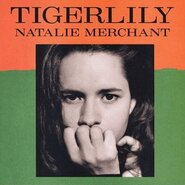
Beloved Wife
By Natalie Merchant
(Tigerlily)

Box of Rain
By Grateful Dead
(American Beauty)

Pigs (Three Different Ones)
By Pink Floyd
(Animals)

Skating Away on the Thin Ice of a New Day
By Jethro Tull
(War Child)
Features
Driver Technology: A True Ribbon Headphone
Forget everything you know about headphone drivers. The SR1a uses highly specialized ribbon drivers. Ribbon drivers feature an ultra-thin and flexible aluminum diaphragm (the "ribbon") suspended between two very powerful magnets. While the ribbon is secured at the top and bottom, it is able to move along its edges. Power from the amplifier is applied across the ribbon, which develops a magnetic field. The field opposes and attracts the adjacent magnets and drives the ribbon evenly over its whole surface. The ribbon moves, pressurizes the air around it, and these sound waves are driven to our ears as music.
Low mass and lack of physical suspension are key to ribbon drivers' performance, allowing them to respond to the subtlest of wave formations. As a result, ribbon drivers are highly responsive, detailed, and dynamic.
With speakers, typical tweeters beam very directional high frequencies. The concept of a sweet spot -- where you want to sit for optimal sound -- become very important. Any movement of the head or body out of this spot changes the sound. The sweet spot with ribbon tweeters is larger than with typical dynamic tweeters. But with a full frequency range ribbon headphone, while the sound wave is much shorter to the ear, it provides an amazing presentation. It produces a circular or dipole pattern soundwave.
Headphone ribbon drivers don't need an enclosure to provide lower bass frequencies the way dynamic drivers do. This is because it is easier to set the Fs (free-air resonant frequency) of a ribbon driver. The Fs parameter is the free-air resonant frequency of a speaker. It is the point at which the weight of the moving parts of the speaker becomes balanced with the forces of the speaker suspension when in motion. Dynamic drivers use an enclosure (either sealed or open) to help produce a lower system Fs. The enclosure and driver work together toward a system Fs. In a ribbon driver, however, no enclosure is required to help produce the lower Fs. The RAAL operates at an Fs around 35Hz. This is the best balance between power and bass extension.
Dragon Cables
[Black Dragon Premium Headphone Cable]
I opted to pair the SR1a with a Black Dragon Premium headphone cable in order to counterbalance the analytical nature of the SR1a. The Black Dragon Premium has the same neutral-warm signature as the standard Black Dragon, but with some upgrades such as rhodium-plated connectors that add an extra layer of clarity to your music.
Known for warmth and fullness, the Black Dragon is neither laid back nor lush. It's a great way to add some body to a neutral/linear headphone, and it works well with vocals and a wide range of genres. This cable uses 4 x 21.5 AWG Teflon-insulated UP-OCC copper conductors that enhance depth and definition and smooth out the top end without sacrificing detail. You'll also get more weight in the lower end with a midrange that sounds more musical. Enhancements like premium rhodium-plated Furutech connectors and Mundorf MSolder SUPREME Silver-Gold lend an extra layer of clarity to your music.
What I got from the Black Dragon was a slightly warmer sound without sacrificing any of the wonderful details that the SR1a offered.
Verdict
Third time's the charm. It's a cliche, but it describes my experience with the RAAL-requisite SR1a. It was an appreciation that blossomed rather than bursting into bloom. But once it bloomed, my sound garden was overrun. The first time I listened, I was preoccupied with a less-than-ideal fit. In retrospect, it was my fault; I think I was just too darn eager to start listening to take the time to adjust them to my head. The second time, I slipped them on easily and thought, "Yeah, these sound really good." The third time, though? Wow. Something clicked. I couldn't tear myself away. Not only did I fall in love with what I was hearing, but I realized that hey, these are really, really comfortable -- more so than many traditional headphones that I've tried. You can't bounce around and shake your head with them on, but barring that, you forget they are there.
That the SR1a is a sound experience beyond your wildest expectations is beyond dispute. But it's an experience that comes with caveats, albeit ones you may be willing to accept.
These aren't "throw them on and move about the house (or out of the house)." These are "sit in place and listen like you're listening to speakers." You can't lie down with them on (and if you figure out a way to do so, please let me know). And unless you have a very understanding partner/roommate/office mate, you really have to be by yourself, as there is no sound isolation. (That being said, while those around you can hear what you're listening to, I found that I was mostly unaware of outside sounds while I was listening.)
RAAL-requisite describes the SR1a as a full-range mixing and mastering monitor. I wondered, though, if the SR1a has professional appeal only. I can see it appealing to:
- Gearheads and audiophiles who are looking for the next frontier
- Two-channel listeners who want another option
- Head-fi fanatics who are curious about the "impossible" idea of on-ear speakers
- Hi-fi lovers who can never, ever get enough of detail listening
Whoever you are, I think you will find the SR1a to be a truly amazing product. As far as I'm concerned, RAAL-requisite deserves a gold star (or maybe a ribbon, pardon the pun) for these ear speaker masterpieces.
Featured Products
Related Videos
RAAL SR1a Headphones Unboxing
RAAL-requisite SR1a Headphone Review
Everything You Need to Know About Headphone Drivers





